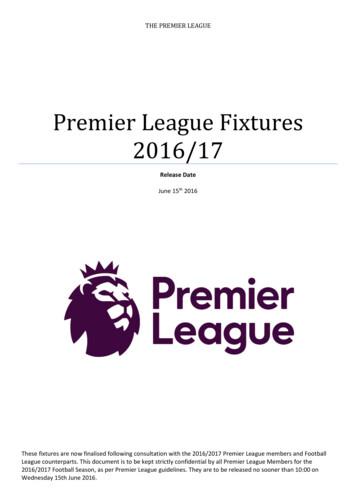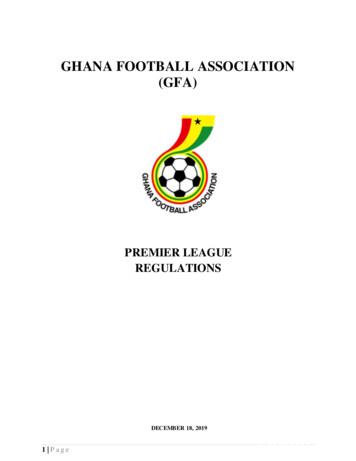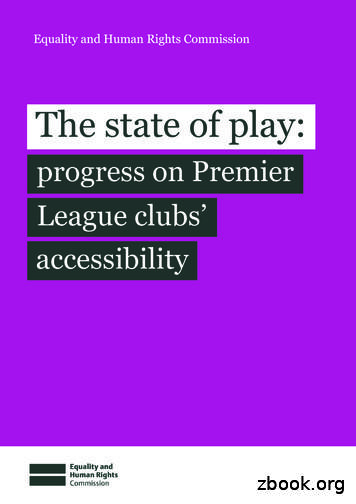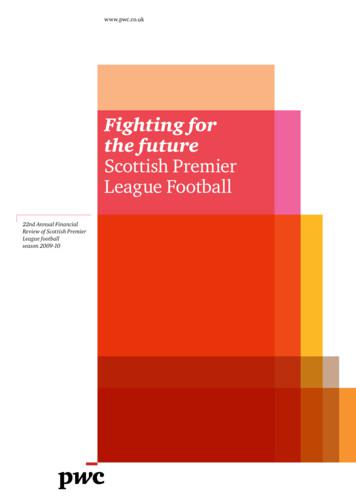Premier League - Ernst & Young
PremierLeagueEconomic and social impactJanuary 2019
Contents1Executive summary2The growth of the Premier League4The economic contribution6From local to global10Supporting the wider game14Community initiatives18
IntroductionThis report explores the economic andsocial contribution of the Premier Leagueand its Clubs to the UK. It is an independentEY study, which has been commissionedby the Premier League. The report focuseslargely on the 2016/17 season and includesevidence of how the League’s impacts haveevolved over time.The Premier League is the elite professionalleague for English and Welsh football,consisting of 20 Clubs and 1,500 registeredprofessional players.DisclaimerThis Report was prepared by Ernst & Young LLP for The Football Association Premier League Limited (“Premier League”) using information provided bythe Premier League and other publicly available data.Ernst & Young LLP does not accept or assume any responsibility in respect of the Report to any readers of the Report (Third Parties), other than thePremier League. To the fullest extent permitted by law, Ernst & Young LLP will accept no liability in respect of the Report to any Third Parties. Should anyThird Parties choose to rely on the Report, then they do so at their own risk.Ernst & Young LLP has not been instructed by its client, Premier League, to respond to queries or requests for information from any Third Party andErnst & Young LLP shall not respond to such queries or requests for information. Further Ernst & Young LLP is not instructed by the Premier League toupdate the Report for subsequent events or additional work (if any) performed by Ernst & Young LLP. Accordingly, without prejudice to the generality ofthe foregoing, Ernst & Young LLP accepts no responsibility to any Third Party to update the Report for such matters.Ernst & Young LLP reserves all rights in the Report.Premier League Economic and social impact1
ExecutivesummaryPremier League footballgenerates a widerange of economic andsocial returnsSince its inception in the1992/93 season, thePremier League and itsClubs (the ‘League’) haveachieved considerable success,establishing a strong globalreputation for high qualityand entertaining football.This is evidenced by thePremier League consistentlyachieving the highest stadiumutilisation figures of any majorEuropean League, alongwith substantial growth inbroadcasting revenue.2007/08the last time the winningclub retained the titlethe following season520,000season ticket holders96.5%stadiumutilisation — the highestrate in Europe43mpeoplewatched the PremierLeague on TV in the UKOne billionhomes globally had access toPremier League coverage2Premier League Economic and social impact
Economic benefitsFrom local to globalThe Premier League and its Clubs generate impacts in a varietyof ways. This ranges from the people they employ to thecommunity work they undertake, as well as the tourism activitythey encourage and platforms they provide to towns, cities andbusiness to engage with the rest of the world. 3.3bnTaxes paid1100,000Jobs supportedThe Premier League is a globally recognised brand, built uponhigh quality football. The League’s global success feeds intoits capacity to generate economic and social returns withinthe UK. 7.6bnThe strength of the Premier League broadcast offering,which is based on a committed global fanbase, is key to itssuccess. In turn, the Premier League has become an activemember of the global community, presenting political andcommercial opportunities for the UK.GVA impact2 1.1bnBroadcastexports 2016Supporting thewider game 350m92InternationalvisitorsCommunity initiativesThe Premier League delivers and supports a widerange of community programmes that aim to promoteimprovements in schools and communities through sportand education.Premier League support for the wider game extends acrossthe football pyramid and communities in England andWales, including all levels of the EFL and into non-Leagueand community football. Parachute or solidarity payments(linked to Premier League broadcast revenues) go to all 72EFL clubs, as well as further funding for their Academies.The Premier League supports the Football Foundation tobuild community football facilities and the Football StadiaImprovement Fund which issues grants to clubs down tolower levels of the FA National League System.Financial support Academies acrossprovided to the the football pyramidwider footballare supported bypyramidthe League’s EPPP3686,000Funding for these programmes has risen substantially asthe League has realised greater success. This has providedlife-changing opportunities to thousands of individuals.In 2016/17 alone, over 500,000 young people took part inPremier League funded programmes. Community footballfacilities delivered via the Football Foundation also sawover one million people participate regularly.747Artificial grasspitches built forcommunity footballto date4150 Football clubssupported todeliver communityprogrammes15,442Primary schoolsengaged in2017/185 throughPremier LeaguePrimary StarsUnless otherwise stated, all statistics on both pages relate to 2016/17. Gross Value Added (GVA) is a measure of economic activity which can be viewed as the incremental contribution to Gross Domestic Product (GDP). It therefore provides auseful measure for understanding the economic contribution made by particular industries, or businesses, such as the Premier League and its Clubs.3Elite Player Performance Programme.4Delivered via the Football Foundation — figures correct to Oct 2018.5 Compared to 20,925 primary schools across the UK in 2016/17, according to the British Education Suppliers Association: /12Premier League Economic and social impact3
The growth of thePremier LeagueFootball is of considerable social, cultural and economic significanceto the UK — football has often been seen as a ‘universal language’which has the ability to inspire and engage communities. During thefootball season, hundreds of thousands of fans travel the countryto follow their team whilst millions more watch live games andhighlights on television and, increasingly, online.1At the pinnacle of the English football pyramid, the activities of thePremier League affect all aspects of the game; from supporting theability of Premier League teams to compete with the best in Europe,to encouraging participation in school and community football.Premier League success is part of a cycle of growthDelivering high quality football is crucial to the success of the League and is at the core of its activities. This drives engagement with fans,and therefore supports commercial performance. In turn, this allows the League to invest in the future of the game to ensure competitiveand engaging football is delivered to fans for years to come. The cycle of growth (below) summarises this process using data examplesfrom this report.Delivering a vibrant andengaging competition thatresonates with fansHigh qualityfootballCommercialSucessInvesting in stadia,facilities and futurefootballing talentImprove andinvestAll Premier League Clubs enhancingaccessibility for disabled people3,752 community pitchesfunded since 200097% stadium utilisation1.3bn fans globallyDistributeequitablyConverting interest intocommercial success andsustainable growth 2.8bn broadcast revenues18 profitable Clubs in 2016/171.6:1 distribution ratiofor central revenues6150 Community organisationssupported across the PremierLeague, EFL and National League.6Supporting widerfootball, communitiesand society he highest-earning Club received 1.6 times the amount received by the lowest-earning Club in 2016/17. In 2018 this ratio was fixed at 1.8:1. Compared to a ratio of 3.7:1 inTLa Liga and 3.2:1 in the Bundesliga.4Premier League Economic and social impact
Full stadiums, engaged fans and world-class talentSince its inception in the 1992/93 season, the Premier League has achieved considerable success and is now widely regarded as themost popular football league in the world.Average/capacity PremierLeagueBundesligaAverage per matchattendancesLa LigaLigue 1AveragecapacitySerie A100%90%80%70%60%50%40%30%20%10%0%Utilisation (%)Stadium utilisation of major European leagues, 2016/17UtilisationSource: Premier LeagueThe League regularly has more players represented ininternational tournaments than any other league; for example,at the 2018 FIFA World Cup, 108 of the 736 players selectedby the competing national teams were Premier League players,38% more than from La Liga. The four nations in the semi-finals ofthe competition were all European and 39 of the 91 players werefrom Premier League Clubs (including 23 from the England team).During the 25 seasons since it was formed, 49 different clubs haveparticipated in the Premier League, with six different Clubs beingcrowned champions. Premier League stadiums have the highestutilisation rates of the major European football leagues (expressedas the percentage sold of the overall available tickets).In 2016/17, Premier League grounds operated at close to fullcapacity with a new record average utilisation across 380 matchesof 96.5%, compared to 93.3% in the Bundesliga (from 306matches).Domestic football leagues with the most players at the2018 FIFA World CupPremier League(England)108La Liga(Spain)78Bundesliga(Germany)62Serie A(Italy)58Ligue 1(France)47Source: VariousPremier League ticketingPremier League Clubs have taken a range of steps to rewardloyal fans and promote the match day experience to fans of allages. This ensures that Clubs have an engaged, sustainablefan base who generate the match day atmosphere.Clubs make tickets available at different price points and offera variety of discounts, including loyalty reward schemes andage-based concessions. In addition, many Clubs opt to freezetheir ticket prices from season to season. The system ofdiscounts means that more than half of attending supporterspay less than the full listed price.In 2018/19, the average (mean) price paid for a ticket acrossall Premier League Clubs is 31 per match (including seasontickets calculated at a per match price); a quarter of fans pay 20 or less. For junior ticket holders, the average cost is 12per match. For away fans specifically, the League has placed a 30 cap on away ticket prices in recognition of their loyalty; athree-season agreement in place since 2016/17. The averageaway ticket price is 28 in 2018/19.Source: Premier League, EY analysis800,000Total seatingcapacity520,00026%Season ticketsOf ticketspurchased at 20 or less 31Average ticketprice 12Average juniorticket pricePremier League Economic and social impact5
The Premier League’seconomic contributionClub and Premier League operationscontribute to economic activity acrossthe UK.The chart opposite highlights some ofthe key statistics which feed into theeconomic impact analysis.These interactions between theLeague and the wider economydrive considerable economicactivity. These can be capturedthrough direct impacts, whichtake place within the Leagueitself (such as Club employment),indirect impacts, through theLeague’s supply chains, andinduced impacts, which aredriven by the employment incomesupported by the League and itssupply chain.7CentralbroadcastrevenueDeliveringPremier Leaguefootball 1.5bnImtsmediate impacspent in Leaguesupply chains12,400FTE directemployees of theClubsPremier League Economic and social impactinternationalvisitor spending811,000Domestic (awayfans) visitorjourneys 1.1bntax contributionsfrom playersClubs have made continued investment in their stadium facilities. This ranges fromentirely new facilities to upgrades — including new stands, refurbishments and improvedaccessibility and facilities for disabled people. Stadium development represents asubstantial programme of private-sector capital investment.EY figures: based on analysis of Premier League information, UK national accounts data and various other sources.6 555mVisitoeCommercial &other revenues 1.7bn686,000internationalvisitor trips 614mPremier LeaguematchdayrevenuesIncomDrivers of impact7 2.8bnomyconre2The popularity of Premier League football drives substantialeconomic activity across the UK. This is supported by the commercialrelationships and supply chains that underpin the League, the visitoreconomy it sustains and the fiscal contributions it makes. Thissection explores this contribution, including the economic returnsgenerated at the national and regional level.
3.3 billion generated in tax revenuesTotal fiscal impact of the League, 2016/17, billionsThe economic activity stimulated by the League resulted in anestimated 3.3 billion total contribution to the Exchequer in2016/17. This represents a 50% increase since 2013/14. Of thetotal contribution, 2.1 billion was a direct impact of the Leagueitself, with the remainder raised through activity supportedindirectly by the League.43This 3.3 billion is a substantial contribution to the UK’s publicfinances. Based on current estimates of hiring and recruitmentcosts, this is equivalent to the annual salaries of over 86,000police constables or would fund the training of more than 42,000new NHS nurses.8,92The diagram opposite illustrates how this tax contribution isbroken down between major tax revenue sources. Playersthemselves accounted for a sizeable proportion of the League’stax contribution. In total, players are estimated to support a taxcontribution of 1.1 billion, or 34% of the 2016/17 total; thevast majority of this contribution was made through players’income-related taxes, which consist of income tax and nationalinsurance s0.2OtherNumbers do not sum due to roundingSource: EY analysisNet VAT payments make up the next largest tax revenue channel,supported to a large extent by the VAT-applicable revenues ofClubs, including that applied to broadcast rights agreements.Premier League players paid 1.1 billionin taxes in 2016/17Overview of impact measurementImpact driversDirect impactsIndirect impactsInduced impactsConsiders theeconomic activitygenerated throughrelevant supplychains as a result ofthe direct impacts(e.g. constructionindustry, hospitalitysector).The economicactivity that issupported byincreased spendingthroughout theeconomy, facilitatedby direct andindirect employmentimpacts. Match day revenue Commercial revenuePremierLeagueClubs Investment Operational spending Community activity Profit/GVA Employees/players Tax contributions Commercial income frombroadcasters and sponsorsPremierLeague Investment Operational spending Community activity GVA Employees Tax contributionsExperienced Police constable salary of 38,533 taken from Prospects: ficer.Nursing training costs of 78,000 per nurse taken from Department of Health (2016). Managing the supply of NHS clinical staff in England.10 Player tax contributions include PAYE income tax and national insurance contributions and VAT, but exclude those paid on other earnings, such as imagerights. These calculations are based on average player salaries.89Premier League Economic and social impact7
7.6 billion contribution to UK GDPTotal GVA impact of the League, 2016/17, billionsThe League’s contribution to UK Gross Domestic Product (GDP)can be estimated through the Gross Value Added (GVA) itgenerates.11 In 2016/17 this reached 7.6 billion, with the majority( 7.2 billion) resulting from Clubs’ operations. This represents a50% increase since 2013/14.12 The chart opposite illustrates howthis GVA contribution is generated through direct, indirect andinduced impacts.876 4In 2016/17, the League directly contributed a total of 4.3billion in GVA to the UK economy, representing 57% of the totalGVA impact. A further 3.2 billion was generated via indirect( 1.4 billion) and induced ( 1.8 billion) impacts. A substantial levelof economic activity is therefore supported through the supplychains of the League, as other businesses contribute to, and sharein the success of Premier League football.FTEs, 000sTotal employment impact of the League, 2016/17, FTE 8TotalDirectIndirectInducedNumbers do not sum due to roundingSource: EY analysisClose to 100,000 UK jobs supported52Total4.35IndirectInducedThe activity of the League supported almost 100,000 full-timeequivalent (FTE) jobs across the UK in 2016/17. This representsa 30% increase since 2013/14. The majority of these jobs wereunderpinned by the League’s substantial supply chains, whichaccounted for 87,000 jobs both through indirect (52,000) andinduced (35,000) impacts. Of the total employment impact,90,300 was supported by Clubs, with the remainder supportedby the Premier League (8,800).Source: EY analysisClubs’ economic impact has risen800% since 1998/9913The increase in revenues has resulted in significant growthin employment supported by the Clubs (excluding the centralactivities of the Premier League itself). This is illustrated bythe number of FTEs rising from 11,300 in 1998/99 to almost90,300 in 2016/17, a rise of 700%. Meanwhile the total taxcontribution underpinned by the Clubs has increased by 2.8billion over the same period, rising by 700% in cash terms.90780670560450403FTEs, 000sGVA and tax, bnThe Premier League’s positive financial performance hasled to an increased contribution from the League to the UKeconomy. The GVA impact from the Clubs has grown from 0.7 billion in 1998/99, to 7.2 billion by 2016/17 — an increaseof over 800% in cash terms, at a compound average annualgrowth rate of ment2016/170Source: EY analysis ross Value Added (GVA) is a measure of economic activity which can be viewed as the incremental contribution to Gross Domestic Product (GDP). It therefore provides aGuseful measure for understanding the economic contribution made by particular industries, or businesses, such as the Premier League and its Clubs.12 Note that improvements in the understanding of Premier League supply chains has produced revised economic impact estimates for 2013/14. Previously the GVA andemployment impacts were estimated at 3.3bn (revised to 4.7bn) and 95,000 (revised to 71,000).13 Changes over time are presented in cash terms. For comparison, ONS data suggest that nominal GDP growth in the UK increased by 98% between 1999 and 2017 and by11% between 2014 and 2017.118Premier League Economic and social impact
Substantial local contributionsRegional distribution of Premier League Clubs, 2016/17The economic activity supported by the League isdistributed across much of England and Wales, dueto the geographical spread of Premier League Clubs.Since its inception, 49 different teams have competedin the Premier League and in 2016/17 each of the majorregions of England and Wales had at least one PremierLeague Club.The greatest impact is felt within London, where a total GVAimpact of 2.3 billion and an employment impact of 27,000 FTEswere underpinned by the activities of the Premier League and thefive London Clubs (Arsenal, Chelsea, Crystal Palace, TottenhamHotspur and West Ham United).The next largest impact was generated in the North West (Burnley,Everton, Liverpool, Manchester City and Manchester United),GVA contribution of Premier League football,selected regions, billions, thCoastSource: EY analysisGreaterManchester: 1.2bn 6%MidlandsSouthCoastGreaterManchester:11,500 (0.9%)0.1%0.1%Share of regional economy0.5Employment impact of Premier League football, selectedregions, FTE thousands, 2016/17Share of regional economy0with 2.0 billion GVA and 20,000 FTEs. A large proportionof the impact in the North West is felt in Greater Manchester(Manchester City and Manchester United
Premier League Economic and social impact 3 1 Unless otherwise stated, all statistics on both pages relate to 2016/17. 2 Gross Value Added (GVA) is a measure of economic activity which can be viewed as the
THE PREMIER LEAGUE Premier League Fixtures 2016/17 Release Date June 15th 2016 These fixtures are now finalised following consultation with the 2016/2017 Premier League members and Football League counterparts. This document is to be kept strictly confidential by all Premier League Members for the 2016/2017 Football Season, as per Premier .
Ramon Reynoso, Ernst & Young Elisabeth Kulinski, Ernst & Young Andrew Soulier, Ernst & Young Emily Hand, Ernst & Young Gavin Fu, Ernst & Young . Mr. Woodbury stated that the Carson location is having a hard time hearing speakers in Las Vegas. Director Dykema said in 701A.240, we are changing the time frame from February to December to .
Association Premier League Regulations" and the provisions shall be referred to as Articles, Clauses and Sub-Clauses. 2. Control of the Premier League The control and management of the Premier League in the country shall be vested in the GFA. 3. Laws of the Game Each Member of FIFA shall play Association Football in compliance with the Laws of
In September 2015, all Premier League clubs committed to ensuring that by August 2017 they would meet the standards set out in the ASG. This 'Premier League Pledge' was voluntary, but clubs all have legal obligations under the Act. In December 2016, the Commission wrote to all 20 Premier League clubs asking for
Club International: Champions League, Champions League Qualification, Europa League (from round 16), Europa League Qualification, UEFA Super Cup, AFC Champions League, Copa Libertadores, Copa Sudamericana Live Stats leagues The details covered vary from league to league. We have list
of Scottish Premier League (SPL) football. compared to the previous season's run in the Champions League group stage. Making reasonable adjustments for these items shows that the league generated an underlying loss of c 16m. Adjustments ( m) Headline profit 1 Less: exceptional profit adjustment (7) Less: Champions League profit adjustment (10)
Premier League and its clubs (the 'League') have achieved considerable success, establishing a strong global reputation for high-quality and entertaining football, as well as delivering substantial economic and social impacts. Economic impact The Premier League's significant contribution was felt across
the Premier League provides contributions to support the wider football pyramid and various charitable causes. This was about 200m in 2017/18, equivalent to almost 7% of the League's total central revenues for the year. Meanwhile, 211m exited the game in payments by Premier League clubs to agents. As the Premier League and its clubs have























